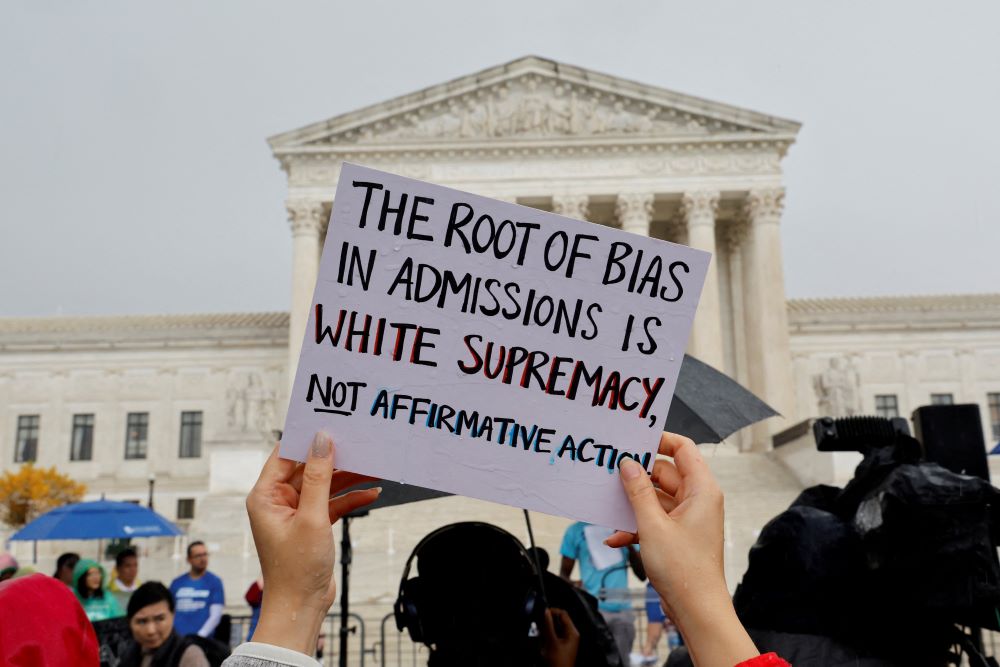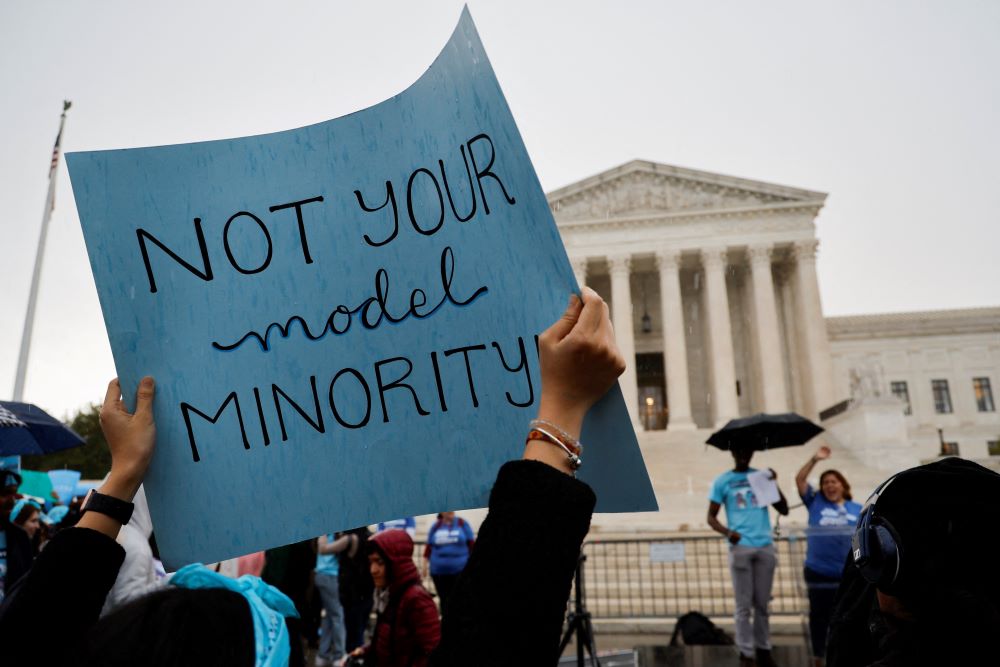
Supporters of affirmative action demonstrate near the U.S. Supreme Court building in Washington Oct. 31, 2022, the day the court heard oral arguments in two cases challenging whether colleges may continue to use race as a factor in student admissions. In a 6-3 ruling, the Supreme Court June 29 struck down race-based admissions at Harvard and the University of North Carolina. (CNS/Reuters/Jonathan Ernst)
Two Supreme Court decisions on June 29 had special significance for those concerned about the intersection of law and religion, and the results couldn't have been more different.
In the first case, Groff v. DeJoy, an evangelical Christian sued the postmaster general because he was told he must work on Sundays. The court, in a unanimous decision — that's right, a unanimous decision — sided with the employee. Writing for the court, Justice Samiel Alito said, "an employer must show that the burden of granting an accommodation would result in substantial increased costs in relation to the conduct of its particular business."
It had been 50 years since the court had actually looked at what standard should apply to flesh out the kind of accommodations Title VII of the Civil Rights Act requires, and a lot of regulations had been passed since. The fact that the decision was unanimous is a big, flashing light to those who think they can override the religion clauses of the First Amendment for any but the most extreme reasons.
The second decision was more controversial, and more contested. It addressed two challenges to the affirmative action policies at Harvard University and the University of North Carolina brought by an advocacy organization, Students for Fair Admissions.

Supporters and opponents of affirmative action demonstrate near the U.S. Supreme Court building in Washington Oct. 31, 2022. In a 6-3 ruling, the Supreme Court June 29 struck down race-based admissions at Harvard and the University of North Carolina. (CNS/Reuters/Jonathan Ernst)
The chief justice set out the court's history of rulings on race and the 14th Amendment's equal protection clause. "Despite the early recognition of the broad sweep of the Equal Protection Clause, the Court—alongside the country—quickly failed to live up to the Clause's core commitments," Roberts wrote.
For almost a century after the Civil War, state-mandated segregation was in many parts of the Nation a regrettable norm. This Court played its own role in that ignoble history, allowing in Plessy v. Ferguson the separate but equal regime that would come to deface much of America.
After half a century wrestling with the "separate but equal" regime the court had established, they finally struck down Plessy in the landmark 1954 Brown v. Board of Education, by which the court, and with it the country, "began on the path of invalidating all de jure racial discrimination by the States and Federal Government. The conclusion reached by the Brown Court was unmistakably clear: the right to a public education 'must be made available to all on equal terms.' "
Roberts continues his argument for what amounts to a colorblind legal status. "Eliminating racial discrimination means eliminating all of it," the chief justice writes.
Accordingly, the Court has held that the Equal Protection Clause applies 'without regard to any differences of race, of color, or of nationality' — it is 'universal in [its] application.' Yick Wo v. Hopkins, 118 U. S. 356, 369. For '[t]he guarantee of equal protection cannot mean one thing when applied to one individual and something else when applied to a person of another color.' Regents of Univ. of Cal. v. Bakke, 438 U. S. 265, 289–290.
Roberts insists the court had previously "permitted race-based admissions only within the confines of narrow restrictions. University programs must comply with strict scrutiny, they may never use race as a stereotype or negative, and — at some point — they must end."
Associate Justice Sonia Sotomayor wasn't having it. Reading her dissent from the bench, she defended the legal regime the court was now declaring unconstitutional:
Although progress has been slow and imperfect, race-conscious college admissions policies have advanced the Constitution's guarantee of equality and have promoted Brown's vision of a Nation with more inclusive schools.
But, given the court's holding now, "the Court cements a superficial rule of colorblindness as a constitutional principle in an endemically segregated society where race has always mattered and continues to matter."
Sotomayor details the long history by which racism persisted despite the loft ideals articulated in the nation's founding documents, and after the 13th and 14th Amendments ostensibly eradicated racism from our constitutional fabric. It persisted, sometimes with benefit of the law, sometimes by skirting the law, sometimes by ignoring the law. And, in an argument that the originalists among the conservative justices should have better heeded, Sotomayor notes,
Simultaneously with the passage of the Fourteenth Amendment, Congress enacted a number of race-conscious laws to fulfill the Amendment’s promise of equality, leaving no doubt that the Equal Protection Clause permits consideration of race to achieve its goal.
The history of the Freedman's Bureau, which she encapsulates, makes it clear: The political branches that enacted the 14th Amendment's equal protection clause understood that sometimes you need to consider race to overcome the ill effects of racism in pursuit of a colorblind ideal.
Associate Justice Ketanji Brian Jackson wrote a separate dissent, focusing only on the North Carolina case because she had recused herself from the Harvard case. She echoed, in arresting terms, Sotomayor's critique of the majority opinion. "With let-them-eat-cake obliviousness, today, the majority pulls the ripcord and announces 'colorblindness for all' by legal fiat. But deeming race irrelevant in law does not make it so in life."
There is an argument to be made that affirmative action has outlived its purpose, that it was needed to provide opportunities to those who had been traditionally marginalized but that it could not become a permanent feature of any constitutionally permitted system because it specifically, and intentionally, denies equal protection of the law in its means in order to achieve equal protection of the law in its ends.
There is also an argument to be made that universities should be permitted to enact, or abrogate, policies that seek to flesh out the meaning of the words "equal protection" in more fulsome ways, enacting policies that undoubtedly cause harm to some people at the margins in order to right a massive, historic injustice, especially because that injustice remains such a part of our society.
Advertisement
It was my understanding that the classic, conservative legal approach values judicial deference, the idea that it is the court's job to defer to the political branches when assessing arguments that necessarily mix prudential considerations with moral and political ideals. Congress, not the courts, is equipped to undertake such prudential, real-world assessments. Unlike the court's recent decision in Allen v. Milligan, permitting racial considerations in evaluating voting rights laws, here they prohibit such considerations. The major difference I see is that no one is harmed by working to make sure minority voters are enfranchised, while real people are harmed by college admissions procedures that highlight some characteristics over others.
It is a close call, closer than either the vehement proponents and opponents of affirmative action care to admit. I would have sided with the minority in this case, but admit to misgivings about leaving this to the judgment of the academic institutions themselves. I suspect the consequences on the racial composition of the student body at our nation's leading universities will be less than some people fear, that there are plenty of minority candidates who will make the cut, many of them educated at our Catholic schools. If that does not prove to be the case, Congress will need to act. The evil effects of racism cannot be allowed to persist forever.
Taking the two decisions together, an interesting thought emerges: How would the conservative majority rule if a religious college argued that affirmative action was part of its creed? That would produce some interesting arguments.







